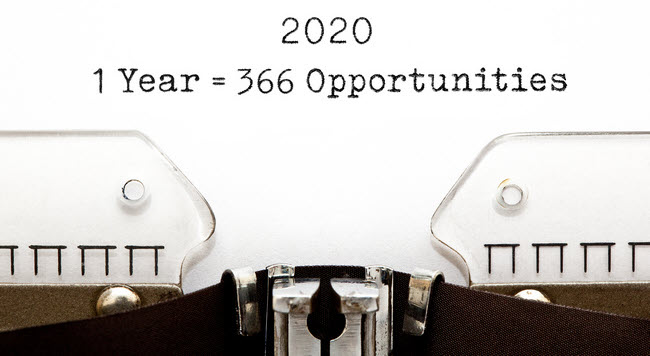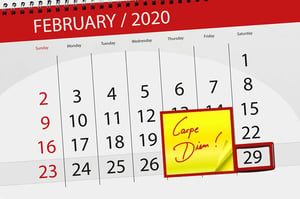
Motivational speakers will tell you that we are constantly surrounded by opportunities and all you need to do to is just reach out and seize them. In fact, this advice is so common, that the phrase “carpe diem” has been around for over 2,000 years and has ingrained itself into virtually every aspect of popular culture.
However, busy business owners and leaders frequently find this entire concept hollow and unattainable. They are overscheduled, over committed, and overtired. There is no extra time in their schedule to tackle anything new, change any unhealthy habits, or even catch up on their ever-increasing to-do lists. Instead, business executives tend to put these things off, in favor of prioritizing their immediate needs and their company’s most pressing demands. Unfortunately, this survival mindset often leads to dysfunctional team dynamics, diminished employee confidence, and flat (or declining) business revenue.
 Instead of hoping for a deadline to be pushed back or for a lengthy meeting to be canceled, carpe diem your way to increased revenue today.
Instead of hoping for a deadline to be pushed back or for a lengthy meeting to be canceled, carpe diem your way to increased revenue today.
The secret to managing your goals effectively is to stop looking at time as your limiting factor. The real barrier to change is established attitudes, habits, and beliefs. Business professionals that simply follow the status quo or are too jaded to believe that they are capable of change will miss out on the opportunity to become the best versions of themselves and grow their businesses.
Do you know what it takes to drive change in yourself and your organization?
Ask Why
Take a third-party approach. Look at what you do in your personal life or business day through the eyes of an outsider. Imagine someone you admire and respect asking you how and why you do what you do. Start with questions like:
- How do you balance work and home life?
- What do you spend most of your time doing?
- Are you happy with your current schedule?
- What kind of efficiency-savers (technology, help resources, additional staffing) are available to free up time on these tasks?
- When and where do you do your best work?
- Do you have pride in the work that you do?
- What do you wish you could change about your responsibilities?
- What do you enjoy doing?
- Do you make enough time to do what you are most passionate about?
- What motivates you?
- Do you feel inspired?
- Who can you turn to for sound advice?
- Where do you want to be in a month, a year, or five years?
These questions will help identify areas for improvement, set objectives, and find the time available to accomplish your goals. Focus on a few of these questions and structure your change efforts around them.
Businesses looking to make organizational changes should ask the same types of questions to ensure that they are building growth around their key focus areas and aligning their efforts with their long-term goals. Analyzing employee strengths, passions, and capacities provides opportunities to make the kinds of changes that can boost revenue and promote sustainable growth.
Businesses looking to make organizational changes should ask the same types of questions to ensure that they are building growth around their key focus areas and aligning their efforts with their long-term goals. Analyzing employee strengths, passions, and capacities provides opportunities to make the kinds of changes that can boost revenue and promote sustainable growth.
Brainstorm
Now that you know what you want to accomplish, decide how you will approach change and set expectations for how your personal change will transform your business. Always frame your own change in the greater context of the business to give it more validity and remind yourself that there is more at stake than just your interests.
No one understands this approach better than the former CEO of T-Mobile, John Legere. In 2012 when Legere assumed the role, he was determined to turn the fledgling company around by repositioning it in the industry. However, he understood that disrupting the industry to grab greater market share required a change in everything – including himself. He changed his image and his leadership approach to revitalize the company, changing the entire wireless industry in the process.
Legere could not have transformed T-Mobile without letting go of what other people expected of him and the pressure that came along with it. He stopped trying to fit into the “CEO mold” and instead grew his hair out, wore T-Mobile t-shirts everywhere he went (even to corporate speaking engagements), traveled the country to share his vision with employees, and communicated directly with the public on social media.
His approach worked because it was rooted in a universal truth – a business cannot succeed without a strong leader. However, the strongest leaders are not always ones that look the part or tout firm rhetoric. The best leaders take care of themselves to stay strong. They prioritize their physical and mental wellness in addition to business improvement. They understand that regardless of size, a business needs a passionate, balanced, capable leader at the helm and that those characteristics cannot exist in an environment of exhaustion and burnout.
Change does not have to be radical – it just needs to be intentional. Look for small tweaks that you can make in your personal life or business operations to move in the direction of the change you want to make. If necessary, set milestones and deadlines to measure progress. Create a change plan to guide your efforts and manage your expectations.
Set Goals
When planning, understand what you want to accomplish, but do not simply focus on the short-term. Remember, the change itself is not the goal. Whatever the change is facilitating is the goal. For instance, automating busy work with a new app is not the goal. Creating a better work-life balance is the goal. Exercising regularly and losing weight is not the goal. Feeling better, having more energy, and improving your overall quality of life is the goal. Take a broader perspective by using a long-term approach to make your change efforts more relevant.
Break the Cycle
Knowing the kind of change you want to make and what you hope to accomplish by doing so is great, but if you do not break the cycle of doing things the way you have always done them, you will never achieve change.
Do not delay getting started. Act immediately to get change underway as quickly as possible. Determine how you will avoid falling back into bad habits and strategize how you will handle slip ups. Foster a culture of change by surrounding yourself with the tools, resources, and people that will help you succeed.
Breaking the cycle is typically much easier for individuals than businesses because companies have bureaucracy and politics to contend with when trying to make changes. The key to changing an organization is to win over employees and engrain change in a way that takes their concerns into account. The result is improved employee satisfaction alongside an upswing in revenue.
Start Small
Some changes may require big shifts in thinking or acting, and these will not come to fruition immediately. Think big and act small. Revolutionary thinking accompanied by tiny changes can sow the seeds for major change.
Remember, even a healthy change can be undertaken in a way that is stressful and taxing. Type A personalities tend to throw themselves into things with abandon, which makes them prone to approaching change with an unhealthy approach. “Change burnout” can occur in the same way that traditional burnout can. This is evidenced every January 19th, when the majority of people give up on their New Year’s resolutions. If you plan on making multiple changes, phase them into your life instead of embarking on them all at once.
Businesses can better analyze the effects of their changes when they undertake them in stages. A more measured approach is often better strategically for organizations and can minimize financial burden when changes are costly to roll out.
Stick with It
Bad habits gradually take root over time. The same is true of good habits.
Change begins with a decision to take a different action and grows with a strategic plan to maintain that decision. It requires a commitment to doing things differently and thinking differently every day. Prioritize ruthlessly in your personal and professional life to continue making the time for the changes that you want to see.
For businesses implementing change, ensure employees understand why the change is important so that they will rally behind it and then incentivize them to maintain changes. Education will provide the staying factor needed for all organizational levels to keep up with changes and positively affect revenue.
This month we have an extra day due to the leap year, will you make the best of it?
Business owners and executives must be willing to focus on themselves (their attitudes, habits, beliefs, and ways of doing things) to strategically take their companies from good to great. Then, they need to be willing to look for ways to change and commit to exploring the opportunities that they find. A strategic revenue growth plan will not work without the right foundation. This kind of change will help you get there.
Download your copy of my Revenue Development Action Plan here to grow your profitable revenue.

